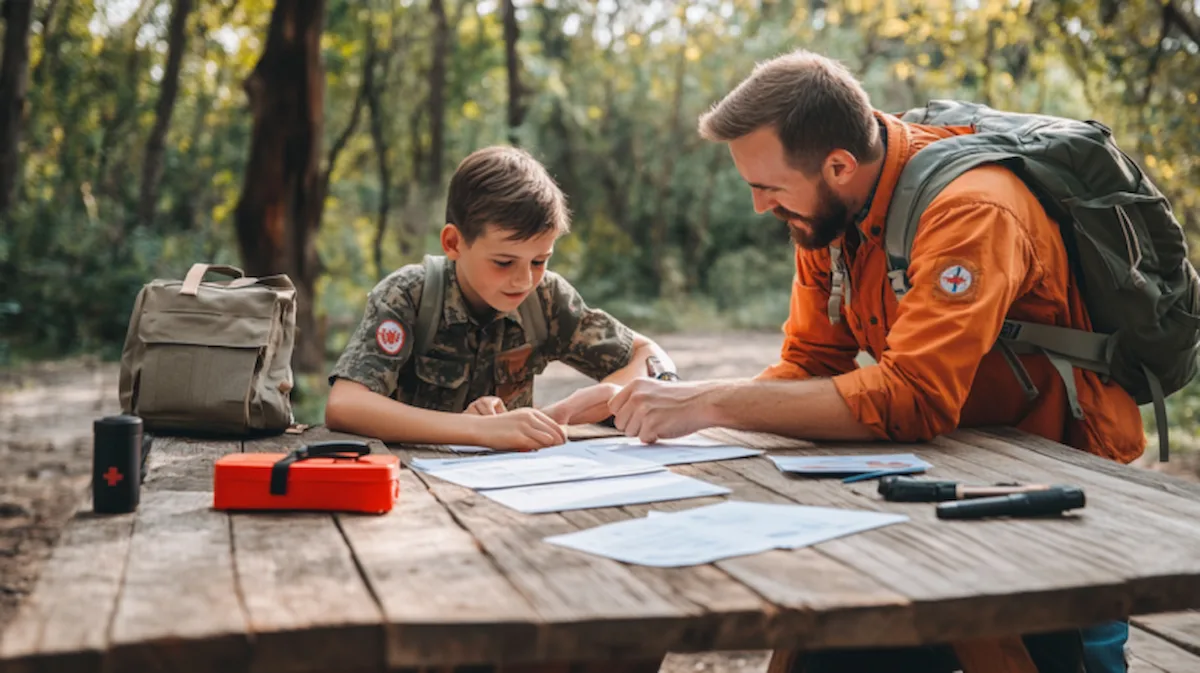Earning the Emergency Preparedness Merit Badge is a major milestone for many Scouts, but navigating the requirements and finding the right emergency preparedness merit badge answers can feel overwhelming. This comprehensive 2025 guide is here to help. Whether you’re preparing for a Scoutmaster conference, working through the merit badge pamphlet, or just want to understand each step clearly, this article will walk you through everything you need to know.
We’ll cover the updated requirements, provide practical tips for answering key questions, and offer example activities to help you confidently earn your badge. With the right guidance, tools, and resources, you’ll find that getting the right emergency preparedness merit badge answers is not only achievable — it’s empowering and essential to becoming a prepared Scout.
What Is the Emergency Preparedness Merit Badge?
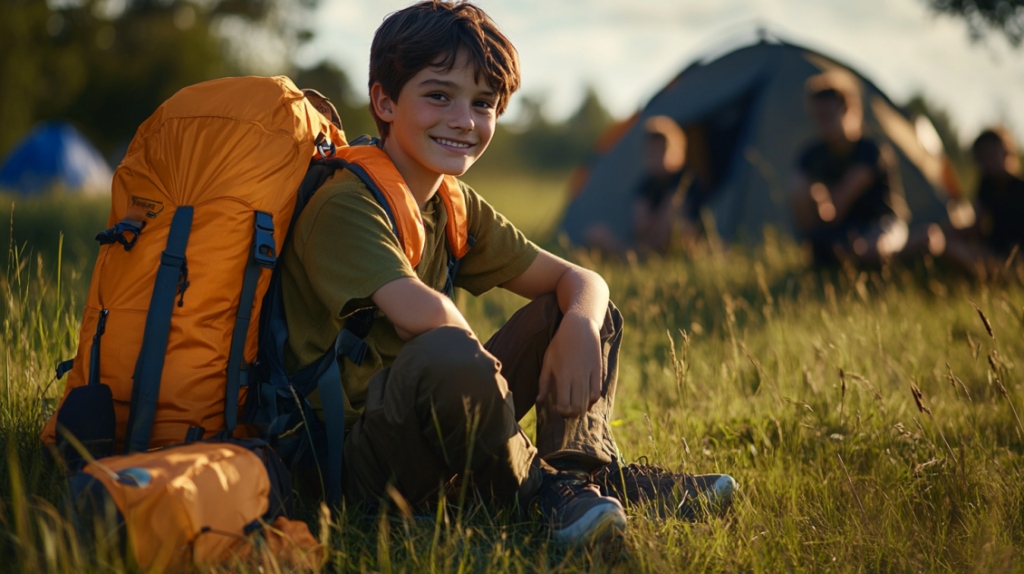
The Emergency Preparedness Merit Badge is one of the most valuable and practical achievements in Scouting. It teaches Scouts how to prepare for and respond to real-world emergencies — from natural disasters to man-made crises. Whether you’re just getting started or looking for emergency preparedness merit badge answers, understanding the purpose behind this badge is the first step toward earning it confidently.
The badge is designed to help Scouts develop a mindset of readiness, leadership, and service. It goes beyond theory by encouraging hands-on learning, problem-solving, and teamwork in emergency situations. This badge is often paired with the First Aid Merit Badge, which is a required prerequisite.
🧠 Key Concepts Scouts Learn Through This Badge:
- Types of Emergencies
Understanding natural disasters (earthquakes, floods, wildfires), home fires, accidents, and public health emergencies. - Personal and Family Preparedness Plans
How to create emergency kits, evacuation plans, and communication strategies. - Scout Emergency Service Roles
Learning how Scouts can assist during community emergencies through volunteer work and readiness. - Leadership in a Crisis
How to lead or assist others calmly and effectively during high-stress situations. - Community Awareness
Knowing local emergency contacts, shelters, and services like FEMA, Red Cross, and local fire departments.
The emergency preparedness merit badge answers you’ll need throughout this process are designed not just to help you pass, but to prepare you to truly be helpful in real-life emergencies — a core value of Scouting.
Full List of Emergency Preparedness Merit Badge Requirements (2025)
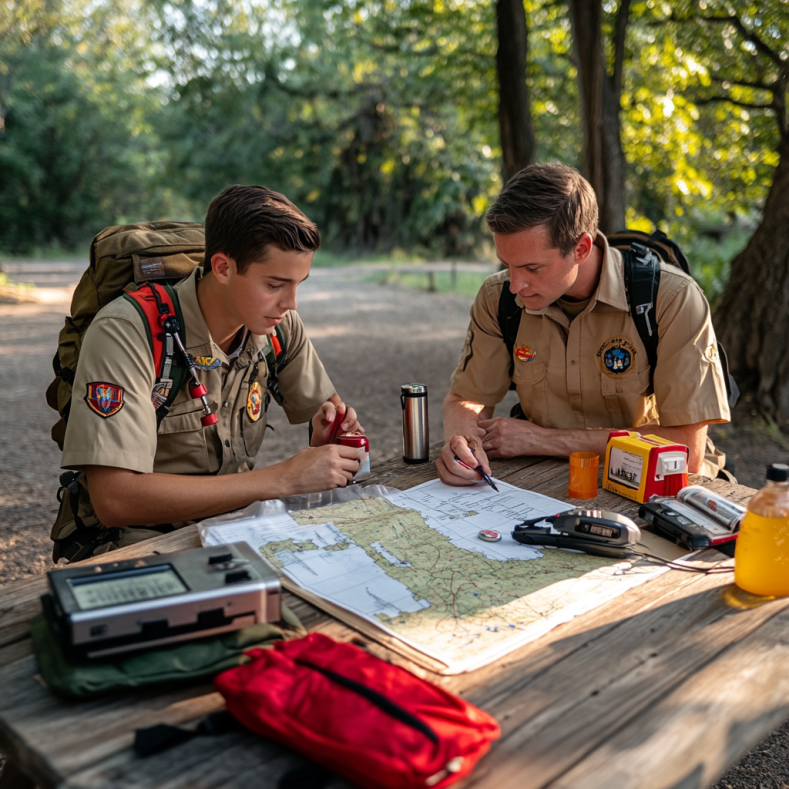
To earn the Emergency Preparedness Merit Badge, Scouts must complete a structured list of requirements that focus on preparedness, response, and recovery in real-world emergency situations. Understanding these requirements is key to giving accurate emergency preparedness merit badge answers and demonstrating true readiness.
Each requirement encourages Scouts to think critically, plan ahead, and take responsibility for their personal safety and the safety of others. While the tasks may seem detailed, they’re designed to build skills that last a lifetime — whether you’re preparing a disaster kit, participating in a drill, or creating a family emergency plan.
Here is the 2025 updated list of requirements, with helpful ideas and examples to guide you:
📝 1. Earn the First Aid Merit Badge
- Why it matters: First Aid is a prerequisite because every emergency situation begins with basic life-saving knowledge.
- Idea: Review your First Aid skills like CPR, treating burns, and wound care.
📝 2. Discuss Emergency Preparedness Principles
- Key points: Types of hazards (natural, human-made), the role of government agencies (like FEMA), and how preparedness minimizes damage.
- Tip: Include emergency preparedness merit badge answers that mention real-world examples such as hurricanes or wildfires.
📝 3. Explain the Importance of Having a Home Emergency Plan
- Task: Create a plan with your family including escape routes, communication strategies, and emergency contacts.
- Example: Use the Red Cross Family Emergency Plan as a guide.
📝 4. Show How to Prepare a Personal Emergency Kit
- Required items: Water, flashlight, battery-powered radio, first aid kit, extra batteries, emergency contact card.
- “Toy” idea: Create a DIY version of an emergency kit with your troop using real materials.
📝 5. Take Part in Emergency Drills
- Activities: Fire evacuation, earthquake drop-cover-hold, severe weather shelter-in-place drills.
- Tip: Document participation and what you learned for your emergency preparedness merit badge answers.
📝 6. Describe the Steps to Take After an Emergency
- Focus: Assessing damage, preventing further injury, and assisting others safely.
- Idea: Role-play this with your troop for better retention.
📝 7. Complete a Scout Emergency Service Project
- Examples: Help install smoke alarms in homes, organize a disaster preparedness event, or distribute emergency flyers in your community.
Each of these requirements not only helps prepare you for emergencies but also gives you the tools to support others. Knowing the emergency preparedness merit badge answers for each of these tasks will not only help you pass the badge — it will prepare you to serve your family and community when it matters most.
Emergency Preparedness Merit Badge Answers and Tips
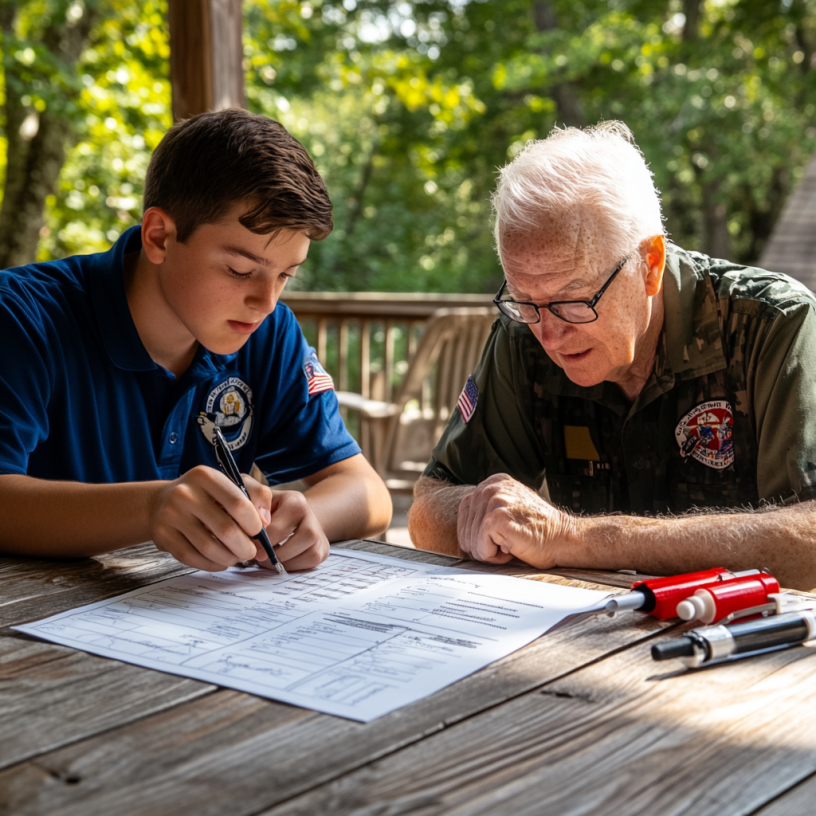
Finding the right emergency preparedness merit badge answers is about more than just passing a requirement — it’s about truly understanding how to respond when it counts. This section provides helpful tips and sample answer ideas that will guide Scouts through common badge questions and help them demonstrate practical knowledge during reviews or Scoutmaster conferences.
While every Scout’s response should reflect their own learning and experience, the examples and strategies below will help you understand what’s expected and how to give strong, accurate, and confident emergency preparedness merit badge answers that meet BSA standards.
Sample Answer Ideas & Tips by Topic
1. Types of Hazards (Requirement #2)
Sample Answer Idea:
“There are three main types of hazards: natural (like earthquakes or floods), man-made (like chemical spills), and technological (like power outages). Being prepared means having a plan and the supplies needed to respond safely.”
Tip: Use local examples (e.g., hurricanes if you’re in Florida).
2. Importance of Family Emergency Plans (Requirement #3)
Sample Answer Idea:
“A family emergency plan includes escape routes, meeting points, and emergency contacts. It’s important so that everyone knows what to do and where to go in case we are separated during a disaster.”
Tip: Draw your plan or use a printable worksheet to explain your strategy visually.
3. Building a Personal Emergency Kit (Requirement #4)
Sample Answer Idea:
“My emergency kit includes a flashlight, extra batteries, water bottles, a whistle, a first aid kit, and a contact list. I also added energy bars and a map of my town.”
“Toy” Idea: Use mini containers or zip pouches for a fun troop activity to build small kits and compare their contents.
4. What to Do After an Emergency (Requirement #6)
Sample Answer Idea:
“After an emergency, I would check myself and others for injuries, avoid unsafe buildings, and call 911 if needed. I would also follow local updates using a battery-powered radio.”
Tip: Practice these steps during a mock drill and write about what you learned.
5. Emergency Service Project Ideas (Requirement #7)
Sample Answer Idea:
“For my project, I handed out flyers in my neighborhood with storm safety tips and helped my troop organize a basic first aid demo at a community center.”
Tip: Keep photos or flyers from your project to show during your merit badge review.
Pro Tip for Scouts:
Use the official Merit Badge Pamphlet and your Scout Handbook while preparing your emergency preparedness merit badge answers. They provide verified information that aligns with BSA requirements — and using them shows you’re serious about mastering the topic and completing the badge with confidence.
Having strong, well-thought-out emergency preparedness merit badge answers will not only help you complete the badge but will give you skills that can truly make a difference during an emergency. Remember, preparation isn’t just about passing — it’s about protecting yourself and others when it matters most.
Practical Activities and Tools to Practice Emergency Readiness
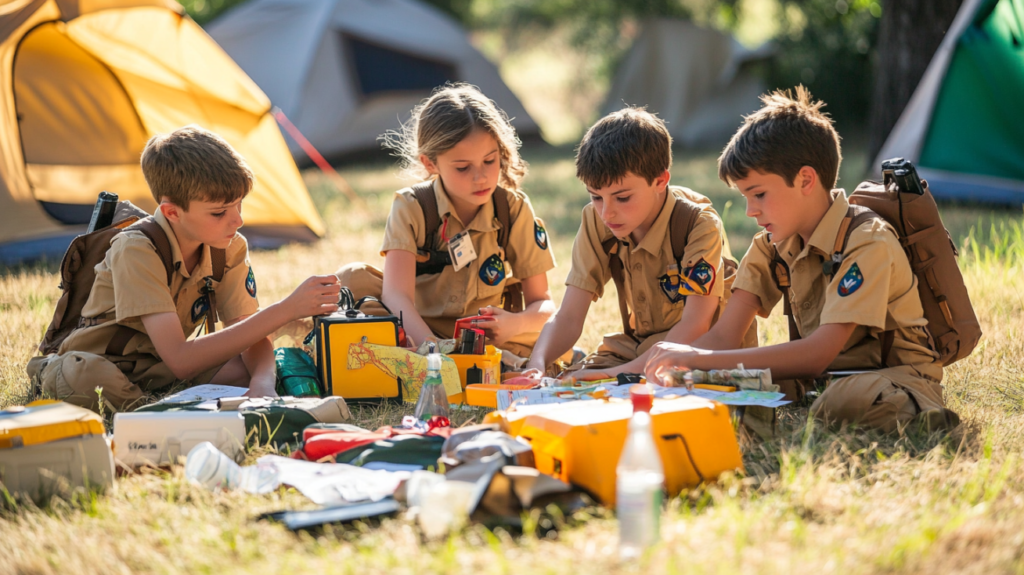
When it comes to earning the badge, knowing the emergency preparedness merit badge answers is important — but putting those answers into action is where real learning happens. Scouts are encouraged to not only study emergency situations but also participate in hands-on activities that prepare them for real-life challenges. These practical experiences help build confidence, quick thinking, and leadership under pressure.
Below are creative and effective emergency preparedness activities and tools that Scouts, parents, and troop leaders can use to reinforce the badge requirements and strengthen their emergency preparedness merit badge answers in an engaging, hands-on way.
1. Build a Personal Emergency Kit (Bug-Out Bag)
Activity Idea:
Create a complete personal emergency kit using real supplies. Make it a challenge: who can build the lightest, most complete kit — a fun way to reinforce key skills while preparing strong emergency preparedness merit badge answers for Requirement #4.
Include Items Like:
- Flashlight & batteries
- First aid supplies
- Emergency whistle
- Water bottle & energy bars
- Local map & contact card
- Hand sanitizer & gloves
“Toy” Version: Let younger Scouts use mini containers and fill them with labeled toy items or printables.
2. Run a Home or Troop Fire Drill
Activity Idea:
Organize a fire evacuation practice with your family or troop. Set a timer and see how fast everyone reaches the meeting point.
Tips:
- Include blocked exit scenarios
- Practice both day and night versions
- Discuss safe evacuation methods afterward
3. Simulate a Shelter-in-Place Drill
Activity Idea:
Create a mock lockdown or severe weather scenario where Scouts must stay indoors with only their emergency kits.
What They’ll Learn:
- What items are missing from their kits
- How to stay calm and occupied
- The importance of communication tools (like radios or walkie-talkies)
4. Design a Community Emergency Plan
Activity Idea:
Divide Scouts into small groups. Each group creates an emergency plan for a specific situation (e.g., flood, power outage, or tornado).
Include:
- Local emergency contacts
- Evacuation routes
- Emergency shelter locations
- Roles for each family or group member
📱 5. Explore Emergency Preparedness Tools & Apps
Recommended Tools:
- FEMA Mobile App – Live alerts and disaster tips
- American Red Cross First Aid App – Step-by-step emergency instructions
- Printable Emergency Checklists from BSA or Red Cross
- Weather radios and whistles for real-life practice
Why These Activities Matter
These fun, interactive activities bring the badge content to life. They help Scouts move beyond memorizing emergency preparedness merit badge answers and start building the mindset and muscle memory needed to act fast and safely when emergencies strike.
Additional Resources for Scouts, Parents, and Leaders
Successfully earning the Emergency Preparedness Merit Badge doesn’t happen in isolation — it takes teamwork, guidance, and the right materials. Whether you’re a Scout working through requirements, a parent supporting your child, or a Scout leader mentoring a troop, having access to quality resources makes the journey toward accurate and complete emergency preparedness merit badge answers much smoother. These tools not only help Scouts stay on track but also ensure their emergency preparedness merit badge answers are thorough, informed, and aligned with the latest 2025 requirements.
Below are hand-picked resources, guides, and support materials tailored for each role — so everyone involved can feel confident, prepared, and fully equipped to complete the badge successfully.
For Scouts: Self-Guided Tools
- Emergency Preparedness Merit Badge Pamphlet (2025 Edition)
– The official BSA guide covering all requirements, diagrams, and example answers. - Merit Badge Worksheet PDF
– Helps Scouts document answers step-by-step with fillable spaces. - Scout Handbook
– A foundational resource that includes emergency skills, maps, and survival basics. - Checklists & Planners
– Printable personal kit checklists, evacuation plan templates, and emergency contacts forms.
For Parents: Support & Supervision Ideas
- Create a Family Emergency Plan Together
– Sit down as a family and fill out a real plan using a worksheet. Talk through each part. - Build the Kit Side-by-Side
– Go shopping together or repurpose household items to assemble a kid-friendly emergency kit. - Mock Drills at Home
– Practice a surprise fire drill or shelter-in-place scenario to reinforce planning and safety. - Watch Safety Videos Together
– Use YouTube or the FEMA site to find age-appropriate clips explaining preparedness.
For Leaders: Troop Activity Resources
- Troop Meeting Plans
– Use BSA’s pre-designed troop meeting outlines to structure badge requirements into your program. - Guest Speaker Ideas
– Invite local EMTs, firefighters, or Red Cross volunteers to speak during a meeting or demonstration. - Group Drills & Projects
– Plan group activities like assembling emergency kits or participating in a community service event related to disaster preparedness. - Merit Badge Counselor Tools
– Use the latest Counselor Guidelines from scouting.org to ensure your review process is structured and fair.
Bonus “Toys” & Tools to Make It Fun
- DIY Emergency Kit Crafts
– Let younger Scouts create their own pretend emergency kits using mini containers and art supplies. - Disaster Scenario Card Game
– Make flashcards with emergency scenarios and ask Scouts how they would respond. - Scout Skill Challenge
– Time-based challenges for tasks like packing a kit, drawing an escape route, or setting up a mock shelter.
Using the right resources helps Scouts not only prepare for their badge review but also gain real-world skills. The more involved parents and leaders are, the more confident Scouts become — and the better their emergency preparedness merit badge answers will reflect true understanding and readiness.
Conclusion
Earning the Emergency Preparedness Merit Badge is more than just completing a checklist — it’s about building real-world skills that can save lives. From understanding the badge requirements to preparing for emergencies with hands-on activities, having clear and reliable emergency preparedness merit badge answers makes a big difference in how confident and capable a Scout becomes.
Whether you’re a Scout studying the emergency preparedness merit badge answers from the official pamphlet, a parent guiding your child through home drills, or a leader organizing troop projects, the tools and tips shared in this guide are designed to help you succeed. By practicing emergency scenarios, building kits, and discussing safety plans, you’re turning answers into action — and that’s the real goal of the badge.
Keep revisiting and refining your emergency preparedness merit badge answers as you learn more, and don’t be afraid to ask questions, test your knowledge, and get hands-on. With the right preparation, not only will you earn the badge, but you’ll also be ready to lead and protect others in times of crisis.
Stay prepared, stay safe — and make every answer count.

